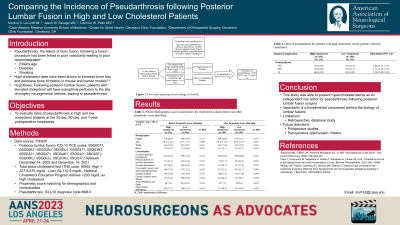Comparing the Incidence of Pseudarthrosis following Posterior Lumbar Fusion in High and Low Cholesterol Patients
Comparing the Incidence of Pseudarthrosis Following Posterior Lumbar Fusion in High and Low Cholesterol Patients
Friday, April 21, 2023


Monish S. Lavu, MHM (he/him/his)
Medical Student
Case Western Reserve University School of Medicine
Cleveland, Ohio, United States
ePoster Presenter(s)
Introduction: Hypercholesterolemia can potentially lead to arthrosclerosis of the segmental arteries which branch into vertebral bone through intervertebral foramina. According to the vascular hypothesis of disc disease, this can lead to ischemia of lumbar discs and contribute to lumbar degenerative disease. Yet, little has been reported about the relationship between cholesterol levels and outcomes of lumbar vertebral fusion surgery.
Methods: Using TriNetX, a global federated research network, we investigated hypercholesterolemia (defined as serum total cholesterol greater than 200 mg/dL by the National Cholesterol Education Program) as an independent risk factor for pseudarthrosis in patients undergoing lumbar fusion surgery. A retrospective cohort study was conducted by identifying patients who received a posterior lumbar vertebral fusion within 3 months of a total blood cholesterol test showing either high or low serum cholesterol between October 2002 and October 2022. High cholesterol (227.5-275 mg/dL) and low cholesterol (82-132.5 mg/dL) were defined as 1 to 2 standard deviations above and below the mean of all lab values in the network, respectively. The occurrence of pseudarthrosis was then assessed in both cohorts at the 30-day, 90-day, and 1 year postoperative periods. Propensity score matching for age, sex, race, and comorbidities was used to balance the two cohorts.
Results: After propensity score matching, there were 320 individuals in both the high and low cholesterol cohorts. High cholesterol patients had significantly greater odds of developing pseudarthrosis 30-days (OR: 1.614, 95% CI: 1.05-2.49), 90-days (OR: 1.58, 95% CI: 1.09-2.28), and 1 year (OR: 1.574, 95% CI: 1.10-2.25) after posterior lumbar vertebral fusion.
Conclusion : The data presented may underscore an often overlooked opportunity for perioperative optimization in lumbar fusion patients. Also, this work further supports the hypothesis that vascularity is a critical factor in the biology of lumbar fusions and supports further investigation in this area.
Methods: Using TriNetX, a global federated research network, we investigated hypercholesterolemia (defined as serum total cholesterol greater than 200 mg/dL by the National Cholesterol Education Program) as an independent risk factor for pseudarthrosis in patients undergoing lumbar fusion surgery. A retrospective cohort study was conducted by identifying patients who received a posterior lumbar vertebral fusion within 3 months of a total blood cholesterol test showing either high or low serum cholesterol between October 2002 and October 2022. High cholesterol (227.5-275 mg/dL) and low cholesterol (82-132.5 mg/dL) were defined as 1 to 2 standard deviations above and below the mean of all lab values in the network, respectively. The occurrence of pseudarthrosis was then assessed in both cohorts at the 30-day, 90-day, and 1 year postoperative periods. Propensity score matching for age, sex, race, and comorbidities was used to balance the two cohorts.
Results: After propensity score matching, there were 320 individuals in both the high and low cholesterol cohorts. High cholesterol patients had significantly greater odds of developing pseudarthrosis 30-days (OR: 1.614, 95% CI: 1.05-2.49), 90-days (OR: 1.58, 95% CI: 1.09-2.28), and 1 year (OR: 1.574, 95% CI: 1.10-2.25) after posterior lumbar vertebral fusion.
Conclusion : The data presented may underscore an often overlooked opportunity for perioperative optimization in lumbar fusion patients. Also, this work further supports the hypothesis that vascularity is a critical factor in the biology of lumbar fusions and supports further investigation in this area.
